By Andrew Tonnesen, Seasonal Fisheries Technician From digging worms in your back yard to a million dollar industry, bait is the key to any successful fishing trip. Whether using natural bait or artificial lures, they all fall under the vast category of bait. Bait is what entices the fish to come close, based on how it smells, how it looks and most importantly how it tastes. Following are descriptions of the 5 most commonly used baits for the saltwater experience along the Atlantic coast. From physical characteristics to why and how they are important to use, this article will provide a new perspective about the bait we all so often use.
Atlantic Menhaden
Scientific Name: Brevoortia tyrannus Size: Up to 15 inches Biological Characteristics: Moderately compressed body; silvery in color with a distinct black shoulder spot behind their gill opening Habitat/Range: The Atlantic menhaden is found in coastal and estuarine waters from Nova Scotia to northern Florida. From March to May, menhaden return to the shelf waters off the bay ready to spawn. The young-of-the-year leave the estuary in late fall and join the schools in a southward migration. During the fall and early winter, most menhaden migrate south to the North Carolina capes where they remain until March and early April. Commercial & Recreational Importance: Bait, Chum, Fish oil, Fish meal Fishing Methods/Targeted Species: Bunker can be used to target almost any of the game fish found off our coast. The reason they are such effective bait is because they are very oily and versatile. They can be ground up for chumming bluefish and sharks, chunked into 2-inch pieces for chunking tuna, bluefish and stripers, they can be filleted and cut in strips for fluke, or thrown in whole on a drop line or trap for crabs. Another great application for bunker is live-lining mainly for stripers. Many surf fishermen will find them useful once cut in half, to sit on the bottom since they are much heartier than clams and can withstand rougher waters. Importance of Studies: Menhaden are being studied for their potential ability to remove nitrogen from the Chesapeake Bay. Being filter feeders, scientists predict that menhaden are not only feeding in the bay, but filtering the excess nitrogen form the water. Research is still taking place by researchers and graduate students from the Virginia Institute of Marine Sciences (VIMS). Results are still unclear, and will not be finalized until further research has been completed. Bureau of Marine Fisheries Research: Menhaden are often caught in various sampling surveys, such as our monthly trawls of the Delaware Bay, as well as our annual ocean trawl. Menhaden are taken back to the lab for measurements of age, sex, length, and weight. This information allows our biologists to estimate the total population of menhaden swimming in our coastal waterways. Unique Fact: A Native American name for menhaden was 'munnawhatteaug', which means 'fertilizer', and menhaden are most likely the fish that the Native Americans told the Pilgrims to plant along with their corn.
Scientific Name: Menidia menidia Size: Up to 5.5 inches Biological Characteristics: The Atlantic silverside is a long, slender, and thin-bodied fish with two dorsal fins, a rounded white belly, and large scales. It has a short head with large eyes and a small mouth. Along each side, from the pectoral fin to its caudal fin, is a distinct silver band outlined by a narrow black stripe. Atlantic silversides resemble anchovies, differing mainly by a smaller mouth. Habitat/Range: 0-3 m of water, coastal bays and creeks, salt to brackish waters Commercial & Recreational Importance: Bait Fishing Methods/Targeted Species: Silversides are popular for catching fluke and other saltwater fish. Silversides are usually fished on a single hook leader or top and bottom rig, sometimes paired with squid strips. The only downfall is that most bait gets bitten in half, so a rig with a hook closer to the tail may be necessary. Importance of Studies: Common research subjects due to sensitivity to extreme environmental conditions (i.e. low oxygen levels, vast temperature changes, pollutants) Bureau of Marine Fisheries Research: Atlantic Silversides are seen in most of our research efforts. They are a common sample in both trawls, our seine project on the Great Egg Harbor and Maurice Rivers, as well as occasionally showing up in our Delaware River seine survey. Silversides are measured for length, and the data is used for various applications. Unique Fact: Silversides have a short lifespan of about 2 years, while most die after spawning at 1 year of age.
Scientific Name: Fundulus heteroclitus Size: Maximum length is 5 to 6 inches, but adult mummichogs are seldom more than 3½ to 4 inches long
Habitat/Range: Coast of North America, from the Gulf of St. Lawrence to Texas. Port au Port Bay, on the west coast of Newfoundland Commercial & Recreational Importance: Bait Fishing Methods/Targeted Species: They are top fluke bait and are sometimes used for catching other species of saltwater fish. If kept cool and moist, minnows can survive in a bait bucket or small cooler for long periods of time. For flounder, live mummichogs or other minnows are usually fished on a single hook leader or top and bottom rig. Importance of Studies: Mummichogs and other species of killifish are used extensively in scientific studies, including medical and environmental research, and have been introduced to many areas for controlling mosquito larvae. (South Carolina, DNR) Bureau of Marine Fisheries Research: Mummichogs are a common occurrence in our Delaware, Great Egg Harbor, and Maurice River seine projects. They are measured for length and that data is used in varying applications. Unique Fact: The mummichog is a member of the Cyprinidae family whose members also include the goldfish and the carp. CAMOUFLAGING: These fish, like many other species, have developed a color-changing defense system for the constant changes during the day in water depth and available light. The advantage of their natural camouflage when applied to fishing is actually for better visibility, rather than to allow them to hide.
Scientific Name: Anguilla rostrata Size: Up to 4 feet and 17.5 pounds Biological Characteristics: Slender snakelike body that is covered with a mucous layer, which makes the eel appear to be naked and slimy despite the presence of minute scales. A long dorsal fin runs from the middle of the back and is continuous with a similar ventral fin. Variations exist in coloration, from olive green, brown shading to greenish-yellow and light gray or white on the belly Habitat/Range: Found in freshwater, estuarine and marine habitats from Greenland to South America. They are bottom dwellers, focusing their habitat around structures, vegetation, holes and burrows. Commercial & Recreational Importance: Bait for fishing for sport fishes or as food in some areas. Their recruitment stage, the glass eel, are also caught and sold for use in aquaculture, although this is now restricted in most areas. Fishing Methods/Targeted Species: The most common use for eels as bait is for catching striped bass, primarily during late summer thru the fall. Eels are most often drifted from a boat, although they can be fished from a stationary boat or from land. Anybody can drift an eel. It just takes a little getting used to the handling of them. Importance of Studies: Studies involving eels are still trying to answer the basic questions about the species, since little is known about them. The Eel Project is collaboration between the New York State Department of Environmental Conservation and several local schools, in which volunteers monitor baby eels in local streams. Their efforts are helping to answer some of the many basic questions we don't yet understand about American eels: When do they migrate? Do they migrate all at once or steadily over the season? How big are they? How many are there? Are populations changing? Bureau of Marine Fisheries Research: American eels have their own projects within the Bureau of Marine Fisheries. We conduct a survey in late winter months for glass eels, as well as the late spring and late fall months for yellow eels. The purpose of these surveys is to measure and assess the population of eels in our freshwater streams as well as our bays. They are also found in our seines and trawl projects. Unique Fact: Eels are catadromous meaning they migrate from fresh water down into the sea to spawn
Common Name: Spot, Norfolk Spot Scientific Name: Leiostomus xanthurus
Biological Characteristics: Small, stout fish with a distinct dark spot behind the gills Habitat/Range: estuary and coastal waters from Massachusetts to Texas Commercial & Recreational Importance: Bait as well as food in high end seafood markets Fishing Methods/Targeted Species: Spot are usually live lined for big fluke and striped bass. When hooking the spot, put the hook thought the top of the mouth and out through the nostrils. Be careful not to use too large of a hook which can cause damage to your bait. If hooked properly, spot will stay alive for a few hours, unless a bigger fish finds it first. Importance of Studies: There are currently no studies being conducted on spot. Aquaculture is being attempted in New Jersey. Bureau of Marine Fisheries Research: Spot can be found in our seine projects where they are measured for length. They are also found more frequently in our trawl surveys, in which they are measured for length and weight. This information helps us get a better understanding of the total population. Unique Fact: New Jersey has the first and only aquaculture program designed to boost spot's potential commercial worth. CONCLUSION With the above information, anglers can not only learn more about the bait being used, but also why each works the way it does. There's also information about how these species impact people not only on a fishing level but how each fish has an environmental niche. As anglers, we can use this knowledge to our advantage to take home good memories and perhaps a true trophy fish as well. REFRENCES AND INFORMATION
Atlantic Menhaden
Atlantic Silverside
Mummichog
American Eel
Spot |
|||||||||||
|
||
|
|
||
|
||
| |
||

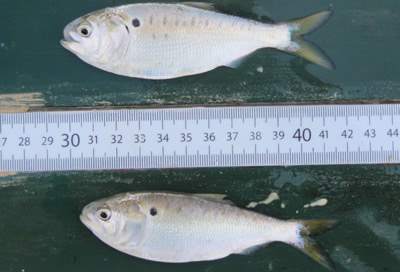
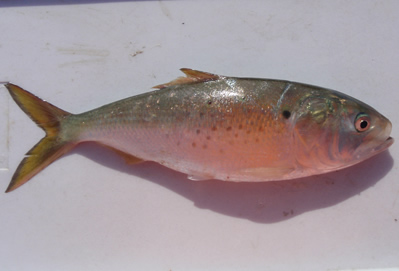
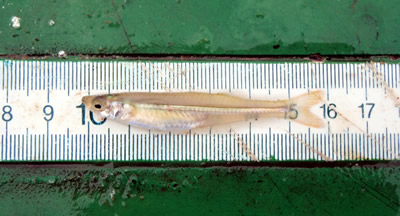
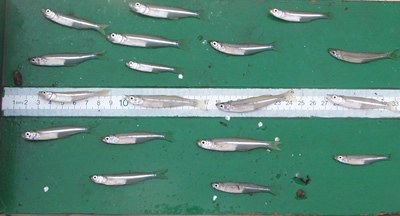
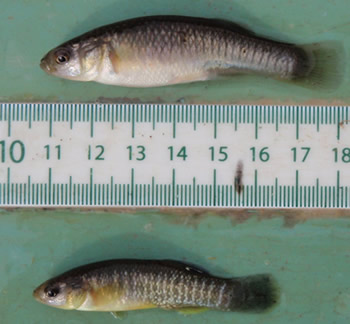 Common Name: Killies, Minnows, Minnie, Chub
Biological Characteristics: This is a stout-bodied little fish, about one-fourth as deep as long, its body thickest just back of the pectoral fins, whence it tapers to the tail. Both its back and its belly are rounded, but the top of the head is flat between the eyes. The snout, as seen from above, is blunt.
Common Name: Killies, Minnows, Minnie, Chub
Biological Characteristics: This is a stout-bodied little fish, about one-fourth as deep as long, its body thickest just back of the pectoral fins, whence it tapers to the tail. Both its back and its belly are rounded, but the top of the head is flat between the eyes. The snout, as seen from above, is blunt.
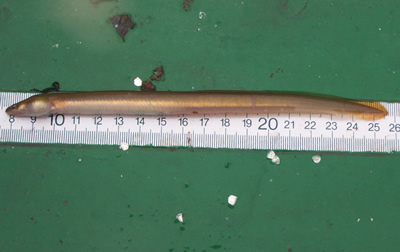
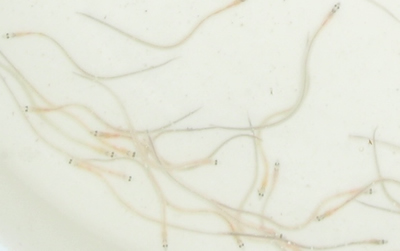
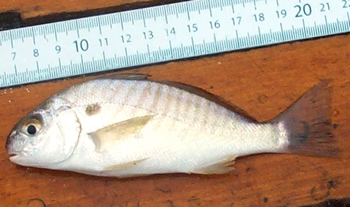 Size: Not to exceed 1 pound and 5 inches
Size: Not to exceed 1 pound and 5 inches